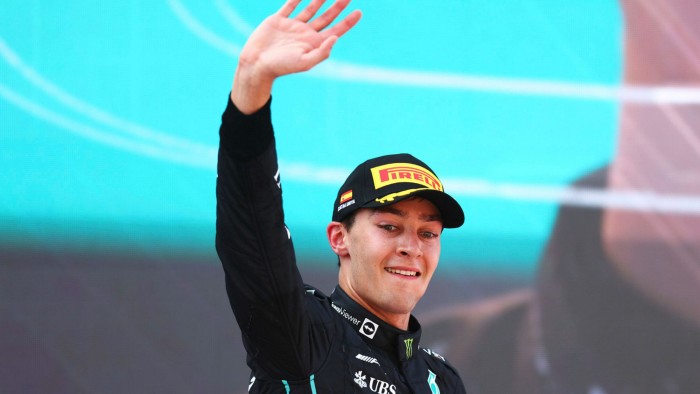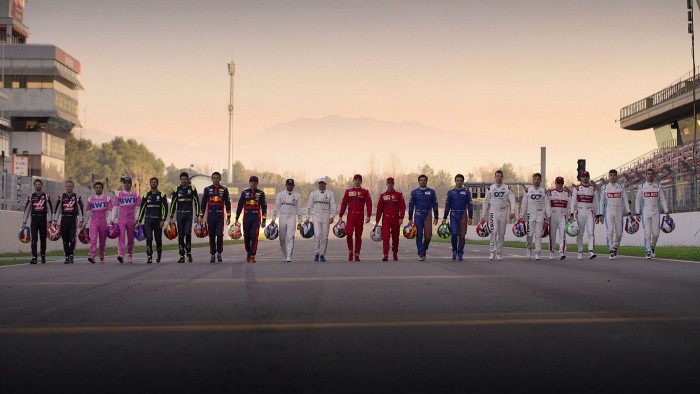George Russell joins troubled Mercedes F1 team

Roula Khalaf, Editor of the FT, selects her favourite stories in this weekly newsletter.
Imagine going head to head with the greatest driver in the history of Formula One, in equal cars. That is the challenge that George Russell, a 24-year-old Briton, has taken on this year as Lewis Hamilton’s teammate at Mercedes.
It sounds like the plot for a Netflix drama — so it seems likely the US streaming service will give the story plenty of prominence in the next series of Drive to Survive, the unscripted blockbuster that has turbocharged F1’s global appeal.
The documentary goes behind the scenes to look at the F1 teams for all 23 races of the 2022 world championship. Russell plugged away for three seasons in the back-of-the-grid Williams team, and one of the big plot lines of the last Drive to Survive was his nail-biting wait to learn whether Mercedes would oust Valtteri Bottas to hand Russell his big break. It made the young driver a star before he has even won a Grand Prix.
“My mission is to win, it’s as simple as that,” says Russell. “It doesn’t matter who’s alongside me. I fought my whole life to get to F1. And, now, I’m fighting to be world champion. I recognise the challenge I face alongside Lewis Hamilton. But you have to focus on yourself. So many people get caught up in what other people do. I need to be open, I need to learn and do what is right for me.”
Russell’s CV from the junior categories of motor racing is impeccable. He had impressive wins in both F1 feeder series, following in the tyre tracks of Charles Leclerc, of Ferrari, who is one of the drivers to beat in 2022. He was watched by Mercedes over the past five years, while they were dominating F1 with Hamilton.
Toto Wolff, Mercedes team principal, has had his heart in his mouth once or twice this year as Russell and Hamilton have fought over the same piece of track, but he accepts Russell’s approach. “He’s integrated very well, it’s almost like he’s been here forever,” says Wolff. “I’m happy about the two of them, how they interact.”

Right place, then, but, sadly for Russell, it is the wrong time. His arrival comes just as Mercedes has produced its first uncompetitive car for a decade, after it failed to interpret the new F1 technical regulations as well as Red Bull and Ferrari. Russell is entitled to feel frustrated but he is not giving that narrative air time.
More from this report
America starts to fall in love with Formula One
F1 begins to purr as changes revolutionise motor racing
Cost cap ushers in return to profitability in Formula 1
Hope of a 100% green fuel leads Formula One’s efforts to tackle climate change
Benedetto Vigna will keep Ferrari’s technology in pole position
Hamilton inspires industry to accelerate F1 diversity initiatives
Optimistic Michael Andretti knocks on F1’s door . . . but will the other teams let him in?
“It’s a unique situation Mercedes find themselves in, having been the dominant force for eight years,” Russell says. “People expected us to go out there and things continue as they were. There has been a major regulation change. Not everybody will get it right but I think this offers an amazing opportunity for Mercedes to prove how capable they are to turn this around.”
In this situation, Russell’s hard yards at the back of the grid will help him. He has been raised on complex problem-solving and keeping a positive energy in his team, despite a lack of success. He started this season more strongly than Hamilton, with consistent top five results and even two podium finishes.
“I’m very grateful for those difficult moments because I think, if I jumped into a fast car from day one and had success instantly, obviously that would have been great, but it wouldn’t have developed me into the driver I am today,” he says.
“Within the team, when there is failure, tensions are higher, naturally. Dealing with successes is easy, everybody’s happy. But when things aren’t going as you wish, true colours come out, you learn a lot about yourself. I feel fortunate that I had that experience at the start of my career, because you have to dig deep to come out the other end.”
F1 drivers are a fascinating case study in rapid decision making and balancing risk and reward under pressure. Here again, Russell’s years at the back of the grid have honed his instincts.
“It comes down to preparation and having a rough indication of what you want to try and achieve,” he says. “For example, if you are fighting for the world championship and you make a bad start off the line, you probably want to collect the points and be in damage limitation mode.
“When I was at Williams, one point could be the difference between ninth and tenth in the constructors’ championship, which is a $16mn position. So every single race we knew we needed highest risk, which would give us the reward. If [instead] you’re in a position to earn points week in, week out you have to readjust your risk taken.”
Having career ups and downs shown to the world on Netflix, and presenting your story on social media, only adds to the pressure on today’s sport stars, but Russell is not naive.
“The value that Drive to Survive has had [for] F1 has been immense,” he says. “But, ultimately, you want them to be telling a good story. When I look back at Michael Schumacher’s career, one of the greatest of all time, he was at Ferrari for four years before he won a world championship with them. And, suddenly, he won five in a row.
“So you’ve got to persevere. You can’t ever lose faith. If you believe in the people around you, believe in yourself and work hard enough, it will come towards you at some point.”
FT Scoreboard
Sign up to the FT’s weekly newsletter covering the multi-billion-dollar global sports industry. www.ft.com/scoreboard
Comments